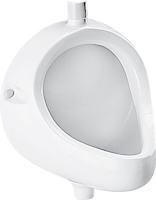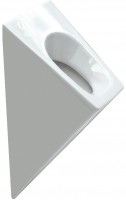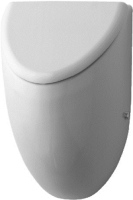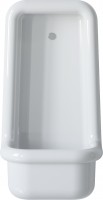Urinals Duravit
All Urinals Advanced filters → |
You might be interested in
Urinals: specifications, types
Collective
Urinals designed to be used by several people at the same time.
Such a product usually looks like a characteristic open capacity from 2 m and more, without express «places» for users. Collective urinals are intended primarily for public toilets. This design is often cheaper and more practical than a set of several separate urinals - the more so that collective models are often made anti-vandal.
Such a product usually looks like a characteristic open capacity from 2 m and more, without express «places» for users. Collective urinals are intended primarily for public toilets. This design is often cheaper and more practical than a set of several separate urinals - the more so that collective models are often made anti-vandal.
Mount
Standard way to install a urinal.
— Hanging. Installation on special wall mounts. In addition to the fact that such urinals do not take place on the floor, they have other advantages over the floor. So, the design is easier, more compact and cheaper, and the height of the installation can be chosen at your own discretion; the latter can be useful, for example, for toilets in entertainment complexes, where you need to provide «children’s» urinals along with «adults». Of course, hanging structures have to be mounted on the wall first, but in the case of urinals this is also required for floor models. Thanks to all this hanging assembly has been the most widespread to date.
— Outdoor. Installation of a urinal with a floor support. Note that such models usually need to additionally fix the attachments to the wall - although they are less demanding to the reliability of such attachments than suspended ones (after all, you just need to prevent tilting, not keep the entire structure on the weight). At the same time, the floor urinals are more cumbersome, heavy and expensive, and the height of the placement of the bowl in them is fixed, you can not choose it at your discretion. As a result, they are much less common hanging and are used for design rather than practical necessity.
— Hanging. Installation on special wall mounts. In addition to the fact that such urinals do not take place on the floor, they have other advantages over the floor. So, the design is easier, more compact and cheaper, and the height of the installation can be chosen at your own discretion; the latter can be useful, for example, for toilets in entertainment complexes, where you need to provide «children’s» urinals along with «adults». Of course, hanging structures have to be mounted on the wall first, but in the case of urinals this is also required for floor models. Thanks to all this hanging assembly has been the most widespread to date.
— Outdoor. Installation of a urinal with a floor support. Note that such models usually need to additionally fix the attachments to the wall - although they are less demanding to the reliability of such attachments than suspended ones (after all, you just need to prevent tilting, not keep the entire structure on the weight). At the same time, the floor urinals are more cumbersome, heavy and expensive, and the height of the placement of the bowl in them is fixed, you can not choose it at your discretion. As a result, they are much less common hanging and are used for design rather than practical necessity.
Corner design
This feature is indicated for urinals originally designed for installation in a corner. They usually have the back of a characteristic shape — in the form of a right angle. Such placement in some cases is the best option, either for practical reasons (to save space) or from a design point of view. At the same time, a serious need for a corner installation rarely arises, therefore there are few models of this type on the market.
Bowl shape
Urinal bowl shape. This parameter has above all an aesthetic value, it practically does not affect the possibilities of the device. In fact, the only relevant point is that bowls with angles (rectangular, rectangular with arc, triangle<68round or oval - due to the actual angles. However, these angles are usually rounded and do not cause serious difficulties, and therefore this deficiency can hardly be considered critical. In light of all this, the choice of the shape of the bowl is primarily due to personal preferences and design requirements.
Water supply
Construction of a pipe for supplying the urinal.
— Hidden. As the name suggests, in such models the nozzle is hidden inside the body and with normal installation outside is not visible. This makes it possible to ensure a neat appearance, without unnecessary hoses and piping. On the other hand, the hidden installation is generally more difficult outside.
— External. The external pipe makes it much easier to connect a hose or water pipeline, but the urinals themselves do not look as aesthetically as the models with a hidden supply.
— Anhydrous. Specific type of urinal, which does not require water supply at all. The drain hole in them is equipped with a specific device (usually an air shutter or a special cartridge) to prevent the spread of unpleasant odors, and the bowl, as a rule, has a special coating that ensures hygiene without constant washing with water. Such models are extremely economical to use, but are themselves quite expensive.
— Hidden. As the name suggests, in such models the nozzle is hidden inside the body and with normal installation outside is not visible. This makes it possible to ensure a neat appearance, without unnecessary hoses and piping. On the other hand, the hidden installation is generally more difficult outside.
— External. The external pipe makes it much easier to connect a hose or water pipeline, but the urinals themselves do not look as aesthetically as the models with a hidden supply.
— Anhydrous. Specific type of urinal, which does not require water supply at all. The drain hole in them is equipped with a specific device (usually an air shutter or a special cartridge) to prevent the spread of unpleasant odors, and the bowl, as a rule, has a special coating that ensures hygiene without constant washing with water. Such models are extremely economical to use, but are themselves quite expensive.
Outlet
Position of the urinal outlet/ opening.
- Horizontal. Output, horizontally located, usually at the rear of the structure.
- Vertical. Output vertically down.
— Universal. Design that allows both horizontal and vertical release, at the user’s discretion. Typically, such urinals have two outlet holes (a pipe), one of which is used and the second is closed. This option is most convenient, but affects the cost of the product.
The choice of the type of outlet depends primarily on the location of the drain pipes in the bathroom and on how best to connect the urinal to them.
- Horizontal. Output, horizontally located, usually at the rear of the structure.
- Vertical. Output vertically down.
— Universal. Design that allows both horizontal and vertical release, at the user’s discretion. Typically, such urinals have two outlet holes (a pipe), one of which is used and the second is closed. This option is most convenient, but affects the cost of the product.
The choice of the type of outlet depends primarily on the location of the drain pipes in the bathroom and on how best to connect the urinal to them.
Automatic drain
Presence in design of the urinal an automatic water drain system.
As the name suggests, such a system provides the discharge itself, without the participation of the user. Its work is based on a sensor that detects either a person in front of a bowl or a hit into a bowl of urine; when this sensor is activated, the water supply is activated (usually not immediately, but after a while - this is the most effective way). Automatic drain is considered not only more convenient, but also more hygienic than manual - it reduces almost to zero the probability of leaving the bowl unscrewed, besides it eliminates the need to touch the handles again, cranes, etc.; the latter is particularly relevant for public toilets. The main drawback of such systems is their high cost; they also require power and become useless when power is cut.
As the name suggests, such a system provides the discharge itself, without the participation of the user. Its work is based on a sensor that detects either a person in front of a bowl or a hit into a bowl of urine; when this sensor is activated, the water supply is activated (usually not immediately, but after a while - this is the most effective way). Automatic drain is considered not only more convenient, but also more hygienic than manual - it reduces almost to zero the probability of leaving the bowl unscrewed, besides it eliminates the need to touch the handles again, cranes, etc.; the latter is particularly relevant for public toilets. The main drawback of such systems is their high cost; they also require power and become useless when power is cut.
Cover installation
Possibility of installation on the urinal cover.
Cover, which closes the bowl during "non-working" hours, increases hygiene and prevents the spread of unpleasant odours. Although it may be initially included in the package (see below), however, the ability to install a cover does not in itself guarantee its presence in the package.
Cover, which closes the bowl during "non-working" hours, increases hygiene and prevents the spread of unpleasant odours. Although it may be initially included in the package (see below), however, the ability to install a cover does not in itself guarantee its presence in the package.
Urinal with "fly"
The presence at the bottom of the urinal of a special mark - most often in the form of a drawn fly, hence the name. «The fly» is designed for the user to try to get into it during urination. This feature not only provides additional entertainment during the use of the toilet, but also improves hygiene: the tag is placed in such a way that the stream coming to this point creates a minimum of spray. This makes it easier to monitor the purity, not only in the urinal itself, but also in the bathroom.
Min. drain volume
Minimum amount of water consumed by urinal during flushing.
In box
Additional equipment included in the delivery of the urinal, in addition to the bowl itself.
— Cover. Cover that closes the bowl. See more about this function. «Installation of the cover», here we note that buying such a kit is usually more convenient than searching for a cover separately.
— Drain mechanism. The device that provides water descent. It usually includes a nozzle, which is responsible for the optimal distribution of water in the bowl, fittings for connection to the water supply and a drain control system. The control system can be different: the simplest variant provides a valve, lever or button to open-close the water manually, and in models with automatic drain sensors and electronic circuits are used (see more. above).
— Siphon. The presence of a siphon supply kit is a characteristic curved pipe for drainage. This package eliminates the need to buy a siphon separately, especially since the complete pipe is optimally suited to the urinal in size. However, it is not impossible to specify the size of the complete siphon and check how it will fit into the intended installation site.
— Cover. Cover that closes the bowl. See more about this function. «Installation of the cover», here we note that buying such a kit is usually more convenient than searching for a cover separately.
— Drain mechanism. The device that provides water descent. It usually includes a nozzle, which is responsible for the optimal distribution of water in the bowl, fittings for connection to the water supply and a drain control system. The control system can be different: the simplest variant provides a valve, lever or button to open-close the water manually, and in models with automatic drain sensors and electronic circuits are used (see more. above).
— Siphon. The presence of a siphon supply kit is a characteristic curved pipe for drainage. This package eliminates the need to buy a siphon separately, especially since the complete pipe is optimally suited to the urinal in size. However, it is not impossible to specify the size of the complete siphon and check how it will fit into the intended installation site.
Antibacterial coating
The presence of a special coating in the urinal that prevents the reproduction of bacteria. This has a positive effect on hygiene; in addition, the antibacterial surface keeps a longer «marketable appearance» and prevents the appearance of unpleasant odors.
Power source
The type of power used in a urinal with electronic components — for example, for automatic flushing.
— Batteries. The main advantage of such urinals is ease of installation — they do not require electricity supply from the network, which eliminates the difficulties of laying wires. However the operating time on one set of batteries is limited, and replaceable batteries usually have to be purchased separately. On the other hand, the electronic components of urinals are usually not particularly “gluttonous” in terms of energy consumption, so that the battery life period is often calculated not even in months, but in years.
— Network. Mains power is convenient because the user does not need to monitor the condition of the batteries and periodically change them — the electronics will work as long as there is voltage. The downside of these amenities is, first of all, some complexity in installation: you need not only to install a urinal, but also to make wiring. The second nuance is that when the electricity is turned off, the urinal can become completely useless.
In general, this option is especially convenient for plumbing used in public places — for example, toilets of train stations, shopping centers, etc.
— Network / batteries. Urinals capable of using both types of supply described above. Usually, in such devices, the main source of energy is the mains, and batteries are used as a backup option in case of power outages.
— Battery.../ generator. Quite an original option: a combination of a generator driven by a stream of water and a battery. In this case, the battery is the direct power source for the urinal electronics, while the generator is used to recharge it as needed. Thus, the power supply is completely autonomous, independent of the mains; and additional maintenance for such devices is practically not required (unlike the same battery-powered models — see above).
— Batteries. The main advantage of such urinals is ease of installation — they do not require electricity supply from the network, which eliminates the difficulties of laying wires. However the operating time on one set of batteries is limited, and replaceable batteries usually have to be purchased separately. On the other hand, the electronic components of urinals are usually not particularly “gluttonous” in terms of energy consumption, so that the battery life period is often calculated not even in months, but in years.
— Network. Mains power is convenient because the user does not need to monitor the condition of the batteries and periodically change them — the electronics will work as long as there is voltage. The downside of these amenities is, first of all, some complexity in installation: you need not only to install a urinal, but also to make wiring. The second nuance is that when the electricity is turned off, the urinal can become completely useless.
In general, this option is especially convenient for plumbing used in public places — for example, toilets of train stations, shopping centers, etc.
— Network / batteries. Urinals capable of using both types of supply described above. Usually, in such devices, the main source of energy is the mains, and batteries are used as a backup option in case of power outages.
— Battery.../ generator. Quite an original option: a combination of a generator driven by a stream of water and a battery. In this case, the battery is the direct power source for the urinal electronics, while the generator is used to recharge it as needed. Thus, the power supply is completely autonomous, independent of the mains; and additional maintenance for such devices is practically not required (unlike the same battery-powered models — see above).
Urinal material
The material from which the urinal bowl is made.
— Sanitary ware("sanitary ware"). One of the most popular materials for modern urinals, at a low cost, it has a neat appearance, is quite durable and reliable. The service life of vitreous china can reach 40 years. Its main disadvantage is the porous structure, which contributes to the accumulation of dirt and odours (although technologies have been recently used to eliminate this drawback), despite the fact that vitreous china is not much cheaper than more resistant vitreous china. As a result, this material is not found very often.
— Sanitary porcelain ("sanitary porcelain"). Like the vitreous china described above, it belongs to ceramic materials, however, with similar strength and appearance, it absorbs water and dirt much less, due to which it has a longer service life — theoretically up to 60 years. Its cost is slightly higher, but in the case of urinals, the difference in price is small. Thanks to all this, vitreous china has become widespread.
— Stainless steel. This material allows you to create products that have an original appearance and fit well into bathrooms with a non-standard design. In addition, stainless steel is much stronger than the vitreous china and vitreous china described above — it is almost impossible to break such a urinal, and it can only be crushed with a special t...ool. On the other hand, with regular use, such reliability is most often simply not required, and steel urinals are much more expensive than ceramic ones. Due to the described features, this material is used very rarely — mainly either in designer models or in products designed for increased vandal resistance.
— Sanitary ware("sanitary ware"). One of the most popular materials for modern urinals, at a low cost, it has a neat appearance, is quite durable and reliable. The service life of vitreous china can reach 40 years. Its main disadvantage is the porous structure, which contributes to the accumulation of dirt and odours (although technologies have been recently used to eliminate this drawback), despite the fact that vitreous china is not much cheaper than more resistant vitreous china. As a result, this material is not found very often.
— Sanitary porcelain ("sanitary porcelain"). Like the vitreous china described above, it belongs to ceramic materials, however, with similar strength and appearance, it absorbs water and dirt much less, due to which it has a longer service life — theoretically up to 60 years. Its cost is slightly higher, but in the case of urinals, the difference in price is small. Thanks to all this, vitreous china has become widespread.
— Stainless steel. This material allows you to create products that have an original appearance and fit well into bathrooms with a non-standard design. In addition, stainless steel is much stronger than the vitreous china and vitreous china described above — it is almost impossible to break such a urinal, and it can only be crushed with a special t...ool. On the other hand, with regular use, such reliability is most often simply not required, and steel urinals are much more expensive than ceramic ones. Due to the described features, this material is used very rarely — mainly either in designer models or in products designed for increased vandal resistance.
Vandal-proof
The urinals are of a particularly robust design, capable of effectively withstanding attempts to damage or dismantle the product.
The main distinguishing feature of most anti-vandal urinals is the material: they are not made of ceramic, but stainless steel, which provides the necessary strength. Of course, this design does not give an absolute guarantee against damage; however, it is very difficult to spoil such a toilet bowl with your bare hands or «improvised means». Individual models are made of sanitary porcelain - they provide increased reliability due to the design features, as well as a special ceramic composition. In any case, vandal models are primarily intended for those public toilets where there is a high risk of vandalism - stadiums, concert halls, some bars and clubs, etc. But for less extreme conditions, this option is not recommended: Technically, nothing prevents it, but anti-vandal urinals are expensive.
The main distinguishing feature of most anti-vandal urinals is the material: they are not made of ceramic, but stainless steel, which provides the necessary strength. Of course, this design does not give an absolute guarantee against damage; however, it is very difficult to spoil such a toilet bowl with your bare hands or «improvised means». Individual models are made of sanitary porcelain - they provide increased reliability due to the design features, as well as a special ceramic composition. In any case, vandal models are primarily intended for those public toilets where there is a high risk of vandalism - stadiums, concert halls, some bars and clubs, etc. But for less extreme conditions, this option is not recommended: Technically, nothing prevents it, but anti-vandal urinals are expensive.
Country of origin
The country of origin of the brand under which the product is presented on the market. Nowadays, you can find urinals under the brands «hail» from Germany, Italy, Poland, Turkey, Czech Republic, France, Switzerland, Sweden.
Assessing the «nationality» of production, it is worth considering two points. First, only the country where the brand is established or where it is headquartered; manufacturing facilities are often located in other countries (one or more). Second, there are many stereotypes about geography - for example, products from Western Europe are considered to be better than Chinese. However, in our time these stereotypes are practically grounded, as the actual quality of products depends primarily on the organization of production in a company. So pay attention to the country of origin of the brand is only in the case if you fundamentally want (or do not want) to support a company from a certain state. In other cases, it is necessary to focus primarily on the general reputation of the manufacturer, not on its origin.





